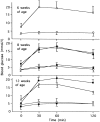Accelerated loss of islet beta cells in sucrose-fed Goto-Kakizaki rats, a genetic model of non-insulin-dependent diabetes mellitus
- PMID: 9708813
- PMCID: PMC1852987
- DOI: 10.1016/s0002-9440(10)65596-4
Accelerated loss of islet beta cells in sucrose-fed Goto-Kakizaki rats, a genetic model of non-insulin-dependent diabetes mellitus
Abstract
The Goto-Kakizaki (GK) rat is a spontaneously diabetic animal model of non-insulin-dependent diabetes mellitus, which is characterized by progressive loss of beta cells in the pancreatic islets with fibrosis. In the present study, we examined the effects of sucrose feeding on the islet pathology in this model. Six-week-old GK rats were fed with 30% sucrose for 6 weeks to induce severe hyperglycemia, and their condition was compared with that of nontreated rats. Age-matched normal Wistar rats were also given sucrose for the same periods and used for comparison. The sucrose-treated GK rats showed elevated blood glucose levels on oral glucose tolerance tests at 60 minutes and 120 minutes, representing 123% and 127% of values in untreated GK rats, respectively. At the end of the study, the mean beta-cell volume density in GK rats was 50% less than that in untreated Wistar rats. Sucrose feeding further reduced the volume densities of beta cells to only 50% of the levels of age-matched GK rats. Apoptotic cells were found in islet beta cells only in GK rats fed sucrose (mean 0.067%). There appeared to be more islets that immunohistochemically stained strongly positive with 8-hydroxy-deoxyguanosine as a marker of oxidative damage of DNA in GK rats fed sucrose compared with those not given sucrose. GK rats not fed sucrose showed significantly lower proliferative activity of beta cells measured by 5-bromo-2'-deoxyuridine uptake and intensified expression of Bcl-2 immunoreactivities at 6 weeks of age compared with those in age-matched Wistar rats. These two indices were reduced in both GK and Wistar rats with increasing age and were not affected by sucrose feeding in either group. The present study thus indicated that sucrose feeding promoted the apoptosis of beta cells in GK rats through increased oxidative stress without altering their proliferative activity.
Figures





Similar articles
-
Asiatic acid mitigates hyperglycemia and reduces islet fibrosis in Goto-Kakizaki rat, a spontaneous type 2 diabetic animal model.Chin J Nat Med. 2015 Jul;13(7):529-34. doi: 10.1016/S1875-5364(15)30047-9. Chin J Nat Med. 2015. PMID: 26233843
-
Hyperglycemia causes oxidative stress in pancreatic beta-cells of GK rats, a model of type 2 diabetes.Diabetes. 1999 Apr;48(4):927-32. doi: 10.2337/diabetes.48.4.927. Diabetes. 1999. PMID: 10102716
-
Augmented beta cell loss and mitochondrial abnormalities in sucrose-fed GK rats.Virchows Arch. 2008 Apr;452(4):383-92. doi: 10.1007/s00428-007-0508-2. Epub 2008 Jan 31. Virchows Arch. 2008. PMID: 18236074
-
Islet gene expression and function in type 2 diabetes; studies in the Goto-Kakizaki rat and humans.Diabetes Obes Metab. 2007 Nov;9 Suppl 2:180-6. doi: 10.1111/j.1463-1326.2007.00787.x. Diabetes Obes Metab. 2007. PMID: 17919192 Review.
-
Selectively bred rodent models for studying the etiology of type 2 diabetes: Goto-Kakizaki rats and Oikawa-Nagao mice.Endocr J. 2023 Jan 30;70(1):19-30. doi: 10.1507/endocrj.EJ22-0253. Epub 2022 Dec 7. Endocr J. 2023. PMID: 36477370 Review.
Cited by
-
Islet beta cell failure in the 60% pancreatectomised obese hyperlipidaemic Zucker fatty rat: severe dysfunction with altered glycerolipid metabolism without steatosis or a falling beta cell mass.Diabetologia. 2009 Jun;52(6):1122-32. doi: 10.1007/s00125-009-1317-8. Epub 2009 Mar 18. Diabetologia. 2009. PMID: 19294363
-
Diabetic fibrosis.Biochim Biophys Acta Mol Basis Dis. 2021 Apr 1;1867(4):166044. doi: 10.1016/j.bbadis.2020.166044. Epub 2020 Dec 28. Biochim Biophys Acta Mol Basis Dis. 2021. PMID: 33378699 Free PMC article. Review.
-
Characterization of pancreatic islets in two selectively bred mouse lines with different susceptibilities to high-fat diet-induced glucose intolerance.PLoS One. 2014 Jan 13;9(1):e84725. doi: 10.1371/journal.pone.0084725. eCollection 2014. PLoS One. 2014. PMID: 24454742 Free PMC article.
-
Sleeve gastrectomy, but not duodenojejunostomy, preserves total beta-cell mass in Goto-Kakizaki rats evaluated by three-dimensional optical projection tomography.Surg Endosc. 2016 Feb;30(2):532-542. doi: 10.1007/s00464-015-4236-4. Epub 2015 Jun 12. Surg Endosc. 2016. PMID: 26065537
-
Effect of fructose or sucrose feeding with different levels on oral glucose tolerance test in normal and type 2 diabetic rats.Nutr Res Pract. 2008 Winter;2(4):252-8. doi: 10.4162/nrp.2008.2.4.252. Epub 2008 Dec 30. Nutr Res Pract. 2008. PMID: 20016727 Free PMC article.
References
-
- Weir GC, Leahy JL: Pathogenesis of non-insulin-dependent (type II) diabetes mellitus. ed 13 Kahn CR Weir GC eds. Joslin’s Diabetes Mellitus, 1994, :pp 240-263 Lea & Febiger, Philadelphia
-
- Cooppan R: General approach to the treatment of diabetes. ed 13 Kahn CR Weir GC eds. Joslin’s Diabetes Mellitus, 1994, :pp 397-403 Lea & Febiger, Philadelphia
-
- Clark A, Wells CA, Buley ID, Cruickshank JK, Vanhegan RI, Matthews DR, Cooper GJS, Holman RR, Turner RC: Islet amyloid, increased A-cells, reduced B-cells and exocrine fibrosis: quantitative changes in the pancreas in type 2 diabetes. Diabetes Res 1988, 9:151-159 - PubMed
-
- Saito K, Yaginuma N, Takahashi T: Differential volumetry of A, B and D cells in the pancreatic islets of diabetic and nondiabetic subjects. Tohoku J Exp Med 1979, 129:273-283 - PubMed
-
- Rahier J, Goebbels RM, Henquin JC: Cellular composition of the human diabetes pancreas. Diabetologia 1983, 24:366-371 - PubMed
MeSH terms
Substances
LinkOut - more resources
Full Text Sources
Medical

